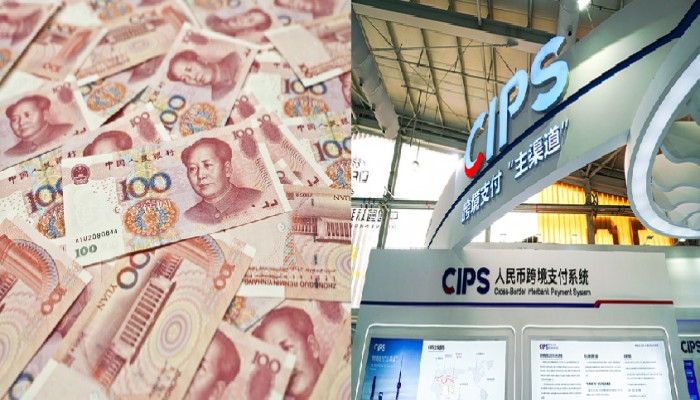Digital Renminbi's Dangerous Shadow Play: Potential 'Financial Nuke'
- In Economics
- 01:04 PM, Oct 29, 2025
- Viren S Doshi
Background
In the complex arena of global financial transactions, where $3 to 4 trillion worth of money flows across borders daily in different currencies and different systems, a subtle, ambitious and sinister shift is underway in the name of de-dollarisation and anti-Americanism.
International financial transactions in CIPS (Crossborder Interbank Payment System) or mBridge using digital renminbi (often called the e-CNY or digital yuan) or RMB is the cornerstone of CCP-occupied China's strategy to challenge the prevalent currency USD (U.S. Dollar), the prevalent system SWIFT (Society for Worldwide Interbank Financial Telecommunication) and mandatory FATF (Financial Action Task Force) scrutiny on money laundering, terrorism financing and WMD (Weapons of Mass Destruction) proliferation financing.
Post 2019 FATF assessment of the effectiveness of CCP-occupied China's measures to combat money laundering, terrorism financing and proliferation financing; it reported back to FATF in 2020 and 2021 on the actions taken to strengthen its AML (Anti - Money - Laundering) / CTF (Counter - Terrorism - Financing) / CPF (Counter - Proliferation - Financing) framework. FATF re-rated the Country on some of the 40 Recommendations and 11 outcomes.
Still, as of the current date, the biggest and most opaque economy, viz. CCP-occupied China is compliant with only 9 Recommendations. It is partly compliant with 25 Recommendations. After 6 years of its assessment, it is still non-compliant on 6 Recommendations. Moreover, it is in need of fundamental changes for 4 outcomes, including the 11th on WMD Proliferation Financing, major changes for 4 more outcomes and moderate changes for 3 outcomes. Not even 1 outcome is satisfactory in its case.
Ironically, none of the globally infamous terrorist entities has ever been declared a terrorist organisation by this big, undemocratic regime. On the contrary, it is seen siding with terrorists at the UN and many other platforms. It is noted to have used its veto repeatedly to save the terrorists from being sanctioned in the UN. It opposes Israel to favour Hamas. It opposes India, to favour Jaish-e-Mohammad and Lashkar-e-Taiba. It openly relates to rogue regimes in North Korea and Iran.
Though CCP-occupied China itself is surprisingly neither in the FATF black list or grey list at present, this opaque monopolistic expansionist economy is in close relations with a FATF black listed country with which it has a common border. It has strategic ties with another blacklisted country and very close ties with many grey-listed countries, including erstwhile grey-listed Pakistan. Almost 99% of rogue regime-ruled North Korea’s trade is with CCP-occupied China, despite UN sanctions. Its imports of iron ore and coal fund the WMD production by Kim's regime.
In this backdrop, its attempts to sideline USD and SWIFT raise grave concerns. That it has its own international digital superfast transaction pathways should definitely be seen as ominous. Amid rising geopolitical tensions, CCP-occupied China is having one well-tested and operational opaque system (CIPS) and is piloting another opaque system (mBridge) operating in e-CNY / RMB to enable faster, cheaper, but unscrutinizable transactions that sidestep SWIFT’s oversight and the USD’s ubiquity.
SWIFT, a Belgium-based cooperative facilitating secure messaging for over 11,000 financial institutions across the globe, underpins worth $190 trillion in annual cross-border retail flows through its messaging, in prevalent currency USD, along with other currencies. It is a compliant, transparent, accessible, time-tested system.
CCP-occupied China’s systems stand distinct from Russia’s System for Transfer of Financial Messages (SPFS) and India’s Special Rupee Vostro Accounts (SRVAs) and Unified Payments Interface (UPI), which are pursued for bilateral convenience. These systems are independent and not connected in any way with CCP-occupied China’s de-dollarisation agenda nor with the CCP-driven de-dollarisation agenda of BRICS. India has explicitly rejected de-dollarisation, with the Reserve Bank of India (RBI) and government authorities emphasising their comfort with USD.
As of now, the e-CNY / RMB pathways remain in an initial and experimental phase for international transactions, with real-value pilots showing feasibility but volumes heavily dwarfed by conventional systems. Hype on social media platforms exaggerates its impact, as a typical leftist fake narrative to impress gullible stakeholders and to mislead the general public, at times claiming it handles 38% of global financial transactions. The reality? It captures hardly 3% of worldwide payments, though it’s gaining traction in certain CCP-occupied China-dominated regions like South East Asia and West Asia / Middle East and CCP-occupied China's Belt and Road Initiative countries.
But a grave concern looms - the Financial Action Task Force (FATF)’s June 2025 report - “Complex Proliferation Financing and Sanctions Evasion Schemes” - flags significant vulnerabilities in the global financial system, specifically with alternative systems like CCP-occupied China’s CIPS using e-CNY / RMB and mBridge using e-CNY and other CBDCs (Central Bank Digital Currencies).
This danger is amplified by CCP-occupied China's 2021 Anti-Foreign-Sanctions Law, enabling sanctions evasion.
It is further compounded by CCP-occupied China's blatant non-compliance with many of the FATF recommendations and poor performance on many of the FATF outcomes.
Its political stance supporting terrorists and rogue regimes across the globe is another malicious attribute that complicates its apparently technological but potentially diabolical fintech initiatives.
Drawing from authoritative sources like the Bank for International Settlements (BIS), RBI, the Central Bank of Russia, SWIFT, FATF and also from an opaque yet ‘official’ source - the People’s Bank of CCP-occupied China (PBOC); this article dissects the RMB / e-CNY’s role, the global financial transaction landscape, and the trust deficit in CCP-occupied China’s non-SWIFT, non-USD dangerous digital pathways that may harbour “financial nukes” in the offing.
Colossal Global Financial Transactions
Cross-border payments—fund transfers between entities in different countries—drive global commerce, investment, loans and remittances. Per a 2025 International Monetary Fund (IMF) working paper, conventional and cryptocurrency cross-border payments reached $1 quadrillion mark in 2024, of course, through different currencies with the prevalence of USD and different systems with the prevalence of SWIFT.
This quadrillion-dollar size global exchange of money—far exceeding global GDP, estimated at $100-105 trillion in USD in 2024 by the IMF and World Bank—reflects the gross value of transactions, including high-frequency, high-value wholesale flows like foreign exchange (FX) swaps and interbank settlements, which crisscross multiple times in the same year, unlike GDP which is yearly economic output.
Out of this worth $1 quadrillion (1000 trillion) annual exchange, wholesale payments driven by FX and capital market activities are worth $800-900 trillion. (As per FXC Intelligence).
Retail flows—business-to-consumer (B2C) e-commerce, person-to-person remittances, and consumer-to-business payments—add volume worth $100-200 trillion, including remittances worth $0.660 trillion (World Bank 2025).
Crypto payments, mainly stablecoins, contribute 1-2% (worth $10-20 trillion, IMF).
Systems and Currencies Used for worth $1 Quadrillion Global Transactions
Apart from direct wholesale forex and bank settlements, SWIFT is still the most prevalent system used for retail financial transactions. It facilitates $190 trillion worth of retail transactions in various currencies, USD being the most prevalent at 50% followed by the Euro at almost 25%; these two cover most of the reported cross-border financial activity by being at least in one leg of the transactions. (The U.S. based Clearing House Interbank Payments System CHIPS processes ~$1.8 quadrillion in domestic and international clearing together per year; this is confined to USD clearing.)
Alternatives like CCP-occupied China's CIPS and CCP-occupied China-dominated mBridge (worth $24.5 trillion, including wholesale and retail flows, mostly in RMB, 2024), Russia’s SPFS (worth $5 trillion, mostly in RUB), and India’s UPI and SRVA (worth $1 to 5 billion, mostly in INR cross-border) are small, but these are growing fast.
Total non-USD non-SWIFT transactions come to around $30 trillion or 3% of $1 Quadrillion global transactions. Likewise, e-CNY / RMB transactions constitute around 3% of all currencies.
USD's Enduring Grip and Challengers
USD anchors almost 90% of FX transactions out of the two sides (100% on one side + 100% on the other side), per the BIS’s 2025 Triennial Central Bank Survey.
USD is also the world’s reserve currency since the 1944 Bretton Woods Agreement. USD’s stability, liquidity, and U.S. legal framework make it the “safe asset” for reserves; 58% of global holdings are in USD as per the Federal Reserve, Q2 2025.
In global trade invoicing, USD still holds up to around 50%.
Declining USD monopoly, still prevailing at almost 50% in all variants, is slowly giving way; mainly due to CCP-occupied China's opaque systems with malevolent potential and partly due to sanctions by the U.S. and the UN, leading to usage of alternative currencies and systems by Russia and India.
(Usage of Euro by Europe for convenience in intra-Europe and cross-Europe transactions is mostly in the same system - the SWIFT, but it also undermines the prevalence of USD.)
(Russia’s RUB, besides reduced share in transactions in SWIFT, confined mainly to still surviving trade with Europe and the U.S., post-2022 SWIFT sanctions, settles 90% of its worth $240 billion trade with CCP-occupied China in RUB-RMB pairs through its SPFS, which was launched in 2014 post-Crimea sanctions, as it had no other option. SPFS connects 177 institutions across 24 countries, processing worth ~$5 trillion in RUB flows.)
(Besides a 0.19% SWIFT share of India's INR standing at eighth number among currencies in SWIFT transactions; India’s UPI - managed by the National Payments Corporation of India - NPCI - handles a very small part of worth $135 billion inward remittances as of FY25 from across 7 countries, with additional cross-border INR flows via Special Rupee Vostro Accounts - SRVAs of 22 countries, settling worth ~$1 to 5 billion in 2025 as per RBI, within RBI’s compliance-focused approach and explicit rejection of de-dollarization. India's IFSC FCSS - International Financial Services Centre Foreign Currency Settlement System - facilitates local settlement of foreign currency transactions in real-time within India in GIFT IFSC.)
In SWIFT retail transactions, projecting on one side, USD’s share is at 49.1% as of August 2025. Euro trails at 22-24%, followed by yen (8%), pound (6-7%) and Canadian Dollar. RMB ranks next at 3.9%.
For CCP-occupied China’s $6 trillion-plus trade, RMB settlements surpassed USD at 52.9% in March 2024 (PBOC). However, when it comes to global trade, the RMB's share is 6%. In global reserves, the RMB share remains at around 2.4%. RMB is emerging as the main and potentially malevolent challenger.
Digital Renminbi and its Dangerous Route CIPS - CCP-occupied China's Tools
The e-CNY, issued by the PBOC, is a centrally controlled central bank digital currency (CBDC), blending cash-like anonymity with blockchain technology, like in crypto transactions. Pegged 1:1 to the physical RMB, like stablecoins, and designed for wholesale and retail cross-border use, it settles trades in seconds at half SWIFT’s 3-5 day costs, making it more loaded and dangerous.
Domestically, it’s just 0.16% of the CCP-occupied China’s M0 money supply, while it fuels RMB internationalisation.
CIPS, an RMB-clearing network, processed RMB 175 trillion (worth $24.5 trillion including all payments like currency swaps and securities etc, along with business payments) in 2024—up 43% YoY—with 8.2 million transactions, averaging RMB 652 billion (worth $91 billion) daily by mid-2025.
Linking 1,690 participants across 119 countries, 80% of its messages also require the use of SWIFT for compatibility.
ASEAN RMB trade hit RMB 5.8 trillion (worth $800 billion) in 2024, with e-CNY piloting 10-20% part of this trade. Russia and India also engage with CIPS for bilateral trade settlements (e.g., RUB-RMB, INR-RMB trades).
CCP-occupied China being an opaque system, the FATF would find it extremely difficult to monitor this system.
CBDC and mBridge: CCP-Occupied China’s Additional Tools - Blockchain Bypass
Project mBridge, co-developed by the BIS Innovation Hub (BISIH) and central banks from CCP-occupied China, Hong Kong, Thailand, UAE and Saudi Arabia, used distributed ledger technology (DLT, or blockchain) for peer-to-peer settlements. BISIH, established in 2019 under BIS’s “Innovation BIS 2025” strategy, operated seven global centres to prototype CBDCs and AI tools for this project. mBridge’s Ethereum-compatible Ledger enables real-time FX swaps, cutting fees by 50%. It reached minimum viable product (MVP) status in mid-2024. Then, BIS exited from this system, handing it over to the participating countries dominated by CCP-occupied China.
Post pilot transactions, this system is likely to be processing 100+ transactions worth <$500 billion projected for 2025 across 39 banks, but details about this system are not published, making it more opaque. It had targeted Asia-Middle East trade— these regions having 38% of global GDP volumes—but BIS wisely exited in October 2024, allegedly amid sanctions fears, leaving the project in secretive doldrums. BRICS was supposed to use a similar system, but India has clearly objected to any efforts towards de-dollarisation by BRICS.
FATF would find it very difficult to monitor this system confined to selected partners, like a private crypto blockchain.
Hype vs. Truth: The 38% Myth
Social media posts from leftist handles misleadingly claim PBOC links “10 ASEAN + 6 Middle East countries” in mBridge / CIPS e-CNY transactions covering 38% of global trade. mBridge status is not clear. CIPS transaction details are published. The 38% figure is the GDP percentage of the 16 countries, not the percentage of transactions of e-CNY or RMB in total transactions, which is around 3% only, as of now. Citing 38% is clearly an attempt to mislead. Typical subtle leftist narrative.
Trust Deficit: Laundering Risks and CCP-Occupied China’s Sanctions Evasion
Non-SWIFT/non-USD transactions via CIPS, mBridge may be faster and cheaper, but these are opaque and more dangerous, lacking transparency and regulatory oversight.
FATF flags significant money laundering, terrorist financing and proliferation financing risks in alternative payment systems like CIPS or mBridge, where RMB / e-CNY’s integration exacerbates blind spots due to its centralised, opaque state-controlled traceability. CIPS’s heavy reliance on SWIFT messaging (80% of flows) creates exploitable gaps, allowing proliferation-sensitive trades—such as dual-use goods exports—to evade detection, as noted in the FATF report’s analysis of complex sanctions evasion schemes.
Specific typologies include the use of CCP-occupied China's banks (like Bank of Kunlun and Bank of Dandong) to facilitate illicit transactions for sanctioned entities like the Ayatollah Regime in Iran and the Kim Jong Un regime in North Korea.
FATF warns that without urgent enhancements in technical compliance and effectiveness, “those seeking to finance WMD proliferation will continue to exploit weaknesses,” particularly in jurisdictions with opaque alternative clearing systems. (For full FATF report, Complex Proliferation Financing and Sanctions Evasion Schemes, see: fatf-gafi.org)
Complementing this, the FATF’s ongoing public consultation (launched February 2025) on PF risks further scrutinises schemes involving virtual assets and CBDCs like the e-CNY, emphasising the need for better typologies in sanctions evasion relevant to WMD PF.
Atlantic Council experts warn that China’s systems, like CIPS, foster financial fragmentation, enabling illicit flows and eroding global standards.
Bottom Line:
Globally, non-SWIFT/non-USD flows are <3% of the $1 quadrillion, but growing.
CCP-occupied China's blatant non-compliance with many of the FATF criteria and poor performance on FATF outcomes, together with connections to FATF black and grey-listed countries, compound its opaque international financial transaction systems, making them potentially harbouring “financial nukes”. This is not just a fragmented fringe pivot; this is a grave danger that can lead to a catastrophe of enormous magnitude.
CCP-occupied China’s financial bypass may scale up further and faster in the name of de-dollarisation and anti-Americanism, but compliance would become many times more critically and perilously dangerous.
This is the time for the free world to unite and act without getting discouraged by subtle but dangerous leftist narratives.
Disclaimer: The opinions expressed within this article are the personal opinions of the author. MyIndMakers is not responsible for the accuracy, completeness, suitability, or validity of any information on this article. All information is provided on an as-is basis. The information, facts or opinions appearing in the article do not reflect the views of MyindMakers and it does not assume any responsibility or liability for the same.







Comments